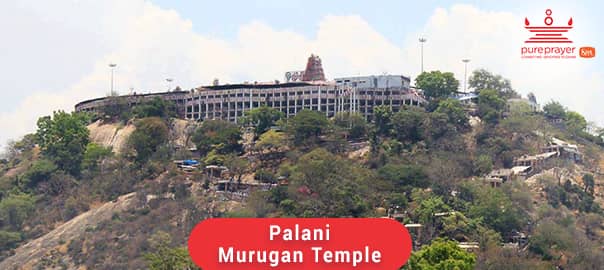Aruppadai Veedu is something that is sacred and very close to the hearts of devotees and followers of Murugan (Lord Subrahmanya). You can click here to know more about the Arruppadaiveedu Yatra presented by Pureprayer.
Aruppadai Veedu are the places where Murugan conducted campaign against a demon king “Surapadman” and defeated him. This is popular as Surasamhara. In honor of Murugan’s victory, temples of Murugan have been built in these six places. The six sacred places are Palani, Swamimalai, Thiruttani, Thiruchendur and Palamudircholai and Thirupparamkundram. Let’s continue our Yatra (journey) with Palani Sri Dandayudhapani temple and learn about this Kshetra during the occasion of ‘Thaipoosam’, an important celebration here.
Palani (Pronounced as-Pazhlani) Sri Dandayudhapani temple is another important Kshetra among Arrupadaai Veedu, the six temples dedicated to Murugan. Palani temple is located in Dindugal district about 485 km from Chennai the capital city of Tamil Nadu state and about 120 km from Madurai city. This temple represents Lord Murugan as a boy contemplating on knowledge and renunciation. Palani is also popular as “Thiru AvinanKudi”. ‘Thiru’ implies Goddess Lakshmi; ‘Avu’ or simply ‘A’ implies the holy cow Kamadhenu; ‘Inan’ implies Lord Surya; ‘Ku’ implies Goddess Earth; ‘Di’ implies Lord Agni. ThiruAvinankudi means the place worshipped by Lakshmi, Kamadhenu, Surya, Earth and Agni.
What is the importance of Palani Dhandayudhapani Temple?
A legend brings out how the Palani came to be a Murugan’s Kshetra. Once, Sage Narada visited Kailash and presented Lord Shiva with a fruit of knowledge. Lord Shiva announced that, whoever completes going round the world three times shall get the fruit of knowledge. Upon hearing this challenge, Kumara Swamy (Murugan) flew off on his vehicle peacock. However, Ganapati just went round Lord Shiva and Parvati three times and stated that his parents are his universe. Happy with his statement, Lord Shiva presented the fruit to Ganapati. Kumara Swamy became unhappy with his failure to understand this simple fact, sadly went to the region now called Palani and sat there. Lord Shiva and Parvati pacified him saying, he was indeed the fruit of knowledge (Tamil-Phazhlam nee). Arunagirinathar mentions about this temple.
Info on the temple:
Palani Murugan temple is situated on a hill called Shivagiri about 450 feet high. 704 steps have been carved into the rock, so that even elephants can climb effortlessly. A funicular railway system has been functioning to help devotees. Devotees also take a sandy route to reach the temple. Devotees first visit the ThiruAvinkudi temple and Sri Pada Vinayakar at the base of the hill before beginning the ascent with Kavadi. There are several lakes on the hills Shivagiri and Shaktigiri that contribute to the river ‘Shanmukha’. On the top, on can see the temple with ornately carved pillars.
A legend associated with the ritual practice of carrying ‘Kavadi’ is as follows:
Sage Agastya was asked by Lord Shiva to move southwards in order to balance the weight of earth during Shiva’s marriage. The great sage agreed and started his journey. He asked his disciple, a giant named ‘Idumban’ to carry two mountain peaks from Kailash to the south. The giant carried the peaks on his shoulders like a ‘Kavadi’. By the time he reached the region of Palani, the giant was exhausted and wanted to rest. He sat aside the mountain peaks and slept. Waking up, he tried to lift the mountain peaks and was shocked to discover they would not budge. He got angered by seeing a small boy preventing the lift. A fight ensued and Murugan, the small boy defeated the giant.
Idumban got to know who the small boy was and prayed him and was granted two wishes. Devotess who carry a Kavadi, the way he carried mountain peaks shall be blessed by Lord Subrahmanya and they should offer obeisance to the image of Idumban before climbing the steps of Palani. Devotees have been performing Kavadi at Palani for ages. Devotees take the vow to have their head tonsured (shaving off the hair). They carry the kavadi and reach the top of the hill and undergo tonsuring followed by bath. They receive the sandalwood paste applied to the deity. This is applied on the shaved head.
Siddhar Bhogar (or Bogar) is another name that finds mention with Palani. Sage Bhogar is said to have created the image of Murugan in Palani using nine types of materials. This technique is called Navapashanam technique. Sage Bhogar is said to be the author of “Saptakanda”, a treatise on alchemy, medicine and many others. A shrine has been created to Bhogar in Palani recognizing his effort.
Temple Architecture:
The image of Dandhayudhapani is said to have been consecrated again during Chera kingdom in 9th Century CE. The corridor around the temple has the hallmark of Pandyan architecture style. Sanctum sanctorum walls of the temple carry extensive inscriptions in Tamil. The Gopuram (tower) above the sanctum is clad with gold sheets. Many sculptures of gods and goddesses can be seen in the corridor and gopuram. It is interesting to note that a Deepastambham has been installed in the front of the temple.
Presiding deity:
Dhandayudhapani, the presiding deity in Palani Murugan temple is in a standing pose with just a lonscloth around his waist. Panchamrita Abhishekam to the image of Murugan is a Puja in great demand in this Kshetra.
What is the best time to visit Palani Dhandayudhapani temple?
Months of December, January and February are the months, with relatively low temperature. However, festival months of AadiMas (Ashadhamas), Kartheekmas, Pangunimas (Phalgunmas), Thaipoosam are chosen by devotees as they are considered very revered.
What is nearby Palani temple?
Palamudircholai is another Arrupadaiveedu Kshetra of importance and about 125 km from Palani. Madurai Meenakshi temple, Palani hills wildlife sanctuary and National Park, Kodaikanal are some of the places of interest.
To be continued


Leave a review